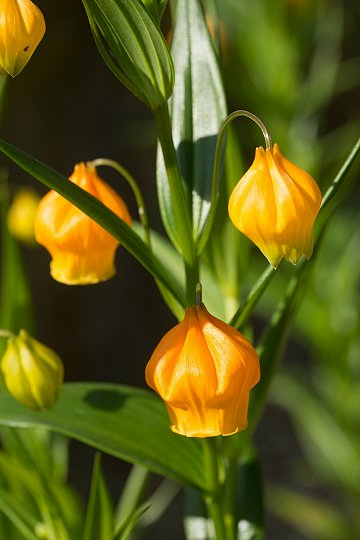
|
|
Sandersonia (Sandersonia aurantiaca).
Flowers.
|
Sandersonia - Sandersonia aurantiaca
Sandersonia is a rhizomatous plant genus native to South Africa
(the Cape Provinces, KwaZulu-Natal and the Northern Provinces) and
Swaziland, part of the family Colchicaceae. It has only one species, Sandersonia
aurantiaca.
Sandersonia aurantiaca is a perennial deciduous plant and a climber reaching up to 1 m
high. The subterranean storage organ or rootstock is a fairly deep-seated, stoloniferous corm consisting of two
swollen, jointed lobes. New growth is produced in spring; the new rootstock and slender aerial stems are produced from a bud at the tip of one of the two
old, swollen lobes. The lance-shaped leaves are arranged alternately along the stem
and, unlike the closely related genera Gloriosa and Littonia, do not usually have tendrils at their
tips.
Sandersonia aurantiaca Hook., is also known as Christmas
bells, golden lily of the valley or Chinese lantern lily or Chinese lantern.
Sandersonia aurantiaca was discovered by the Scottish journalist and amateur botanist John Sanderson in
KwaZulu-Natal in 1851, and was described by Sir William Hooker, director of the Royal Botanic
Gardens, Kew, in Curtis's Botanical Magazine in 1853. The specific epithet aurantiaca is derived from Latin and refers to the orange colour of the flowers
(between yellow and red).
The elegant, lantern-like flowers of S. aurantiaca are borne on long stalks produced in the leaf
axils; they open from the bottom upwards and occur in shades of pale to deep
orange. The fruit is a capsule containing many small, hard brown seeds, without a papery seed
coat, unlike the much larger seeds of Gloriosa and Littonia.
The plant grows naturally in an area ranging from the Eastern Cape through
Transkei, Natal, Swaziland, into the Transvaal. Flowering time is December to January
(Christmas). Sandersonia aurantiaca flowers were once a common sight throughout its grassland and forest margin distribution range in the Eastern
Cape, KwaZulu-Natal, Swaziland and southern Mpumalanga, but severe habitat loss from agricultural expansion and indiscriminate picking of flowers has made it a rare sight in the wild
today; it is usually only seen in nature reserves. It occurs in deep, heavy soil on damp hill slopes in full
sun.
Sandersonia aurantiaca enjoy sandy soil rich with compost but well
drained. They enjoy full sun, but not excessive heat. If heat is excessive, they will require more
watering. They are delicate against being bumped or stepped on. They like to grow upwards and should be
staked. They die back naturally at the end of the season and will return in zones 9 and 10. They do well in San
Francisco, San Diego, and other places with mild climates in which it get neither too hot nor too
cold. They are good for green houses.
The rootstocks of Sandersonia aurantiaca have traditionally been used by the indigenous populations of
Zulu people as an aphrodisiac, to procure the birth of a son or daughter as
desired, and the leaves are also used in combination with other plants in bathing infusions as protection against
evil. The compound colchicine is present in this species, and all parts of the plant should therefore be regarded as potentially
toxic.
Source:
https://en.wikipedia.org/wiki/Sandersonia
http://pza.sanbi.org/sandersonia-aurantiaca
http://medicinalplants.us/sandersonia-aurantiaca-hook-christmas-bells
